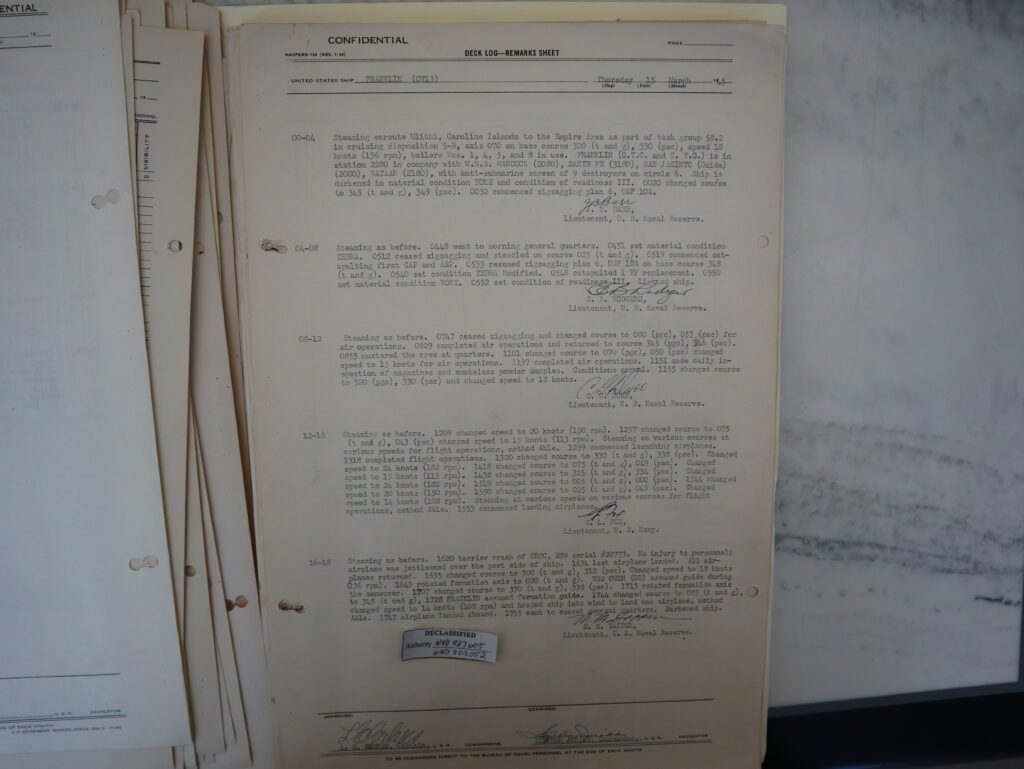USS Franklin Deck Log 15 March-Enroute To The Empire Area
This is the second in a series of daily blog posts drawing from the deck logs of USS Franklin (CV-13), an Essex-class carrier headed into combat in the Pacific Theater of Operations. On 19 March 1945, she would become the most heavily damaged carrier NOT to be sunk during World War II. More notably, her crew would become the most decorated in the history of the US Navy. The first entry covered the Mid Watch, from 0000 to 0400 (12:01 am to 4:00 am.)
Steaming enroute Ulithi, Caroline Islands to the Empire Area as part of task group 58.2 in cruising disposition 5-R, axis 070 on base course 320 (t and g), 330 (psc), speed 18 knots (136 rpm), boilers Nos. 1, 4, 5, and 8 in use. FRANKLIN (O.T.C. AND C.T.G) is in station 2280 in company with U.S.S. HANCOCK (2080), SANTA FE (3180), SAN JACINTO (Guide) (2000), BATAAN (2180), with anti-submarine screen of 9 destroyers on circle 6. Ship is darkened in material condition YOKE and condition of readiness III. 0020 changted course to 345 (t and g) 349 (psc). 0032 commenced zigzagging plan 6, USF 10A.1
(For those needing a translation of the above terms, “OTC” is “Officer in Tactical Command, referring to Admiral Ralph Davison, who flew his flag on Franklin. “CTG” refers to “Commander, Task Group.” The admiral commanded one of four task groups making up Task Force 58. “Material Condition Yoke” is the middle of three conditions of “water-tight integrity. Some of the hatches are closed, but not all. Condition III refers to ship readiness. No attack threat is foreseen in the near term.)

Steaming As Before
It was customary to go to General Quarters in the hours before dawn and as dusk approached in the evenings as it was an opportunity for Japanese aircraft to attack out of the sun when it was near the horizon or when visibility was obscured. Franklin did so at 0448 and catapulted its Combat Air Patrol (CAP) and Anti-Submarine Patrol (ASP) at 0519. Air operations would continue on and off throughout the day as the CAP and ASP landed and replacements were launched to take their places. Speeds and courses varied as the carriers in the task group turned into the wind to launch and retrieve aircraft. The daily inspections of the magazines were found to be normal just before noon.
At 1620 an SB2C divebomber crashed into a barrier protecting parked aircraft. The three-man crew escaped uninjured, but the plane was so damaged that it was shoved over the side of the ship. It didn’t take long to clear the damage as the last plane landed 14 minutes later.

1755 Went To General Quarters. Darkened Ship
As the ship grew darker and safer from air attack, it loosened its readiness conditions going to Material Condition Yoke. At 1940, cruisers USS Pittsburgh and USS Baltimore joined the task group. The last entry was at 2238 when boiler #3 was lit.2
Did you arrive here via a search engine? I am the author of the forthcoming book, Heroes By The Hundreds: The Story of the USS Franklin (CV-13). In addition to writing about the bravery of the crews that saved her, I will write about the lessons we can learn in leadership and decision-making. I’ll also write about the changes the US Navy made because of those lessons learned.
Feel free to follow me on Facebook. There, I am M. Glenn Ross, Author. I also write a monthly newsletter, Glenn’s After-Action Report, about subjects I find interesting in my research. You can sign up for it below. Feel free to leave a comment or ask a question. Thanks for reading-Glenn.